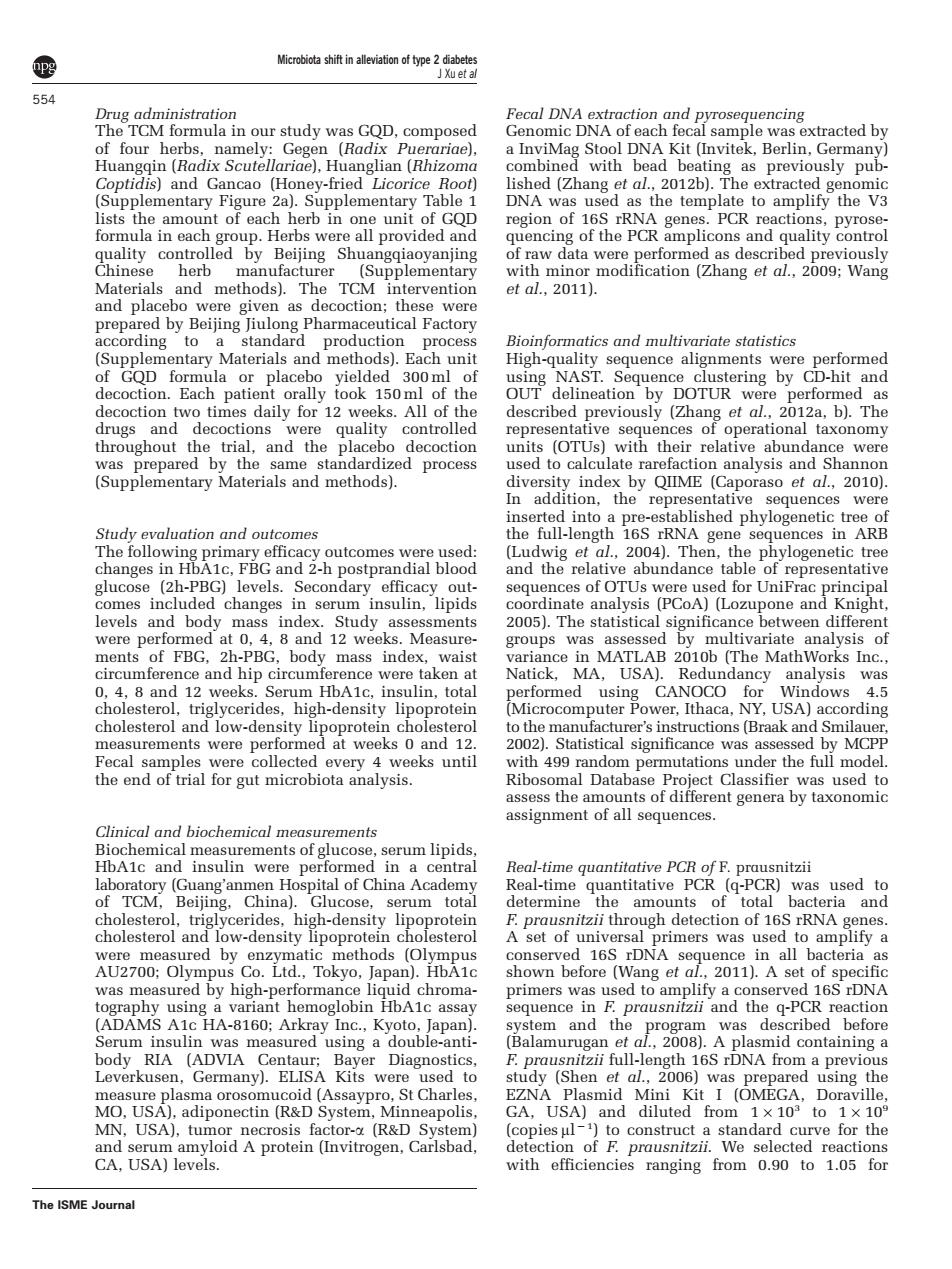正在加载图片...

554 our glian (Rhiz ith bead beati ists the amount oa herb in one unit of GOD Chinese lementary Materials and methods).Each unit ugson two times daily for 12 weeks.All one described previously(Zha g et al,2012a,b).The taxonom hr.the ced process ction analysis and s Shan vels an and of OTUs undance d fo changes n serum insulin,lipids pone and R nigh were perfor d at o 4.8 and 12 weeks.Measur ments sof FBG, Natic ormed ing Microcompute CANOCO for ndows cholesterol and o-density h-density 002. instructions (Braak measurements were per Statisti ce was der the as erent genera by taxonomic signmen sequences Clinical and biochemical measurements oAhemidmentemereomearnmpit Real-time quantitative PCR high-dens ermsnitzith cholesterol an Pset of primers was use was measured by high-perormance iquid chroma LADAMS AIC HA-8160: nd the was de ibed before ody RIA (ADVIA C previ Leverkusen,Germany).ELIS Kits were Cha shen ed Min ing the GA USA)and diluted from 1x 102 t01×10 CA.USA)levels. The ISME Joural Drug administration The TCM formula in our study was GQD, composed of four herbs, namely: Gegen (Radix Puerariae), Huangqin (Radix Scutellariae), Huanglian (Rhizoma Coptidis) and Gancao (Honey-fried Licorice Root) (Supplementary Figure 2a). Supplementary Table 1 lists the amount of each herb in one unit of GQD formula in each group. Herbs were all provided and quality controlled by Beijing Shuangqiaoyanjing Chinese herb manufacturer (Supplementary Materials and methods). The TCM intervention and placebo were given as decoction; these were prepared by Beijing Jiulong Pharmaceutical Factory according to a standard production process (Supplementary Materials and methods). Each unit of GQD formula or placebo yielded 300 ml of decoction. Each patient orally took 150 ml of the decoction two times daily for 12 weeks. All of the drugs and decoctions were quality controlled throughout the trial, and the placebo decoction was prepared by the same standardized process (Supplementary Materials and methods). Study evaluation and outcomes The following primary efficacy outcomes were used: changes in HbA1c, FBG and 2-h postprandial blood glucose (2h-PBG) levels. Secondary efficacy outcomes included changes in serum insulin, lipids levels and body mass index. Study assessments were performed at 0, 4, 8 and 12 weeks. Measurements of FBG, 2h-PBG, body mass index, waist circumference and hip circumference were taken at 0, 4, 8 and 12 weeks. Serum HbA1c, insulin, total cholesterol, triglycerides, high-density lipoprotein cholesterol and low-density lipoprotein cholesterol measurements were performed at weeks 0 and 12. Fecal samples were collected every 4 weeks until the end of trial for gut microbiota analysis. Clinical and biochemical measurements Biochemical measurements of glucose, serum lipids, HbA1c and insulin were performed in a central laboratory (Guang’anmen Hospital of China Academy of TCM, Beijing, China). Glucose, serum total cholesterol, triglycerides, high-density lipoprotein cholesterol and low-density lipoprotein cholesterol were measured by enzymatic methods (Olympus AU2700; Olympus Co. Ltd., Tokyo, Japan). HbA1c was measured by high-performance liquid chromatography using a variant hemoglobin HbA1c assay (ADAMS A1c HA-8160; Arkray Inc., Kyoto, Japan). Serum insulin was measured using a double-antibody RIA (ADVIA Centaur; Bayer Diagnostics, Leverkusen, Germany). ELISA Kits were used to measure plasma orosomucoid (Assaypro, St Charles, MO, USA), adiponectin (R&D System, Minneapolis, MN, USA), tumor necrosis factor-a (R&D System) and serum amyloid A protein (Invitrogen, Carlsbad, CA, USA) levels. Fecal DNA extraction and pyrosequencing Genomic DNA of each fecal sample was extracted by a InviMag Stool DNA Kit (Invitek, Berlin, Germany) combined with bead beating as previously published (Zhang et al., 2012b). The extracted genomic DNA was used as the template to amplify the V3 region of 16S rRNA genes. PCR reactions, pyrosequencing of the PCR amplicons and quality control of raw data were performed as described previously with minor modification (Zhang et al., 2009; Wang et al., 2011). Bioinformatics and multivariate statistics High-quality sequence alignments were performed using NAST. Sequence clustering by CD-hit and OUT delineation by DOTUR were performed as described previously (Zhang et al., 2012a, b). The representative sequences of operational taxonomy units (OTUs) with their relative abundance were used to calculate rarefaction analysis and Shannon diversity index by QIIME (Caporaso et al., 2010). In addition, the representative sequences were inserted into a pre-established phylogenetic tree of the full-length 16S rRNA gene sequences in ARB (Ludwig et al., 2004). Then, the phylogenetic tree and the relative abundance table of representative sequences of OTUs were used for UniFrac principal coordinate analysis (PCoA) (Lozupone and Knight, 2005). The statistical significance between different groups was assessed by multivariate analysis of variance in MATLAB 2010b (The MathWorks Inc., Natick, MA, USA). Redundancy analysis was performed using CANOCO for Windows 4.5 (Microcomputer Power, Ithaca, NY, USA) according to the manufacturer’s instructions (Braak and Smilauer, 2002). Statistical significance was assessed by MCPP with 499 random permutations under the full model. Ribosomal Database Project Classifier was used to assess the amounts of different genera by taxonomic assignment of all sequences. Real-time quantitative PCR of F. prausnitzii Real-time quantitative PCR (q-PCR) was used to determine the amounts of total bacteria and F. prausnitzii through detection of 16S rRNA genes. A set of universal primers was used to amplify a conserved 16S rDNA sequence in all bacteria as shown before (Wang et al., 2011). A set of specific primers was used to amplify a conserved 16S rDNA sequence in F. prausnitzii and the q-PCR reaction system and the program was described before (Balamurugan et al., 2008). A plasmid containing a F. prausnitzii full-length 16S rDNA from a previous study (Shen et al., 2006) was prepared using the EZNA Plasmid Mini Kit I (OMEGA, Doraville, GA, USA) and diluted from 1 103 to 1 109 (copies ml 1 ) to construct a standard curve for the detection of F. prausnitzii. We selected reactions with efficiencies ranging from 0.90 to 1.05 for Microbiota shift in alleviation of type 2 diabetes J Xu et al 554 The ISME Journal���